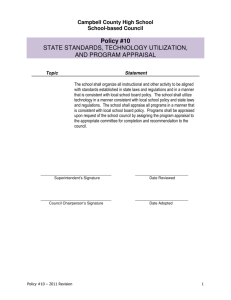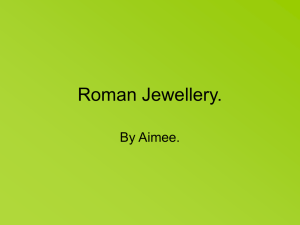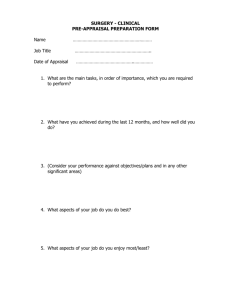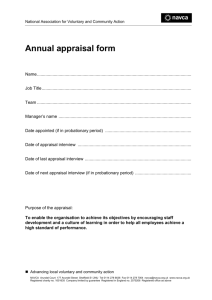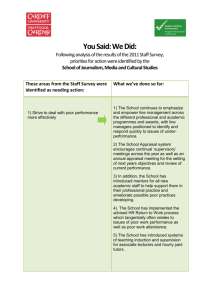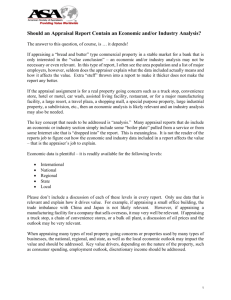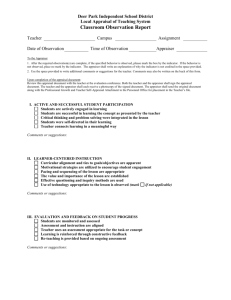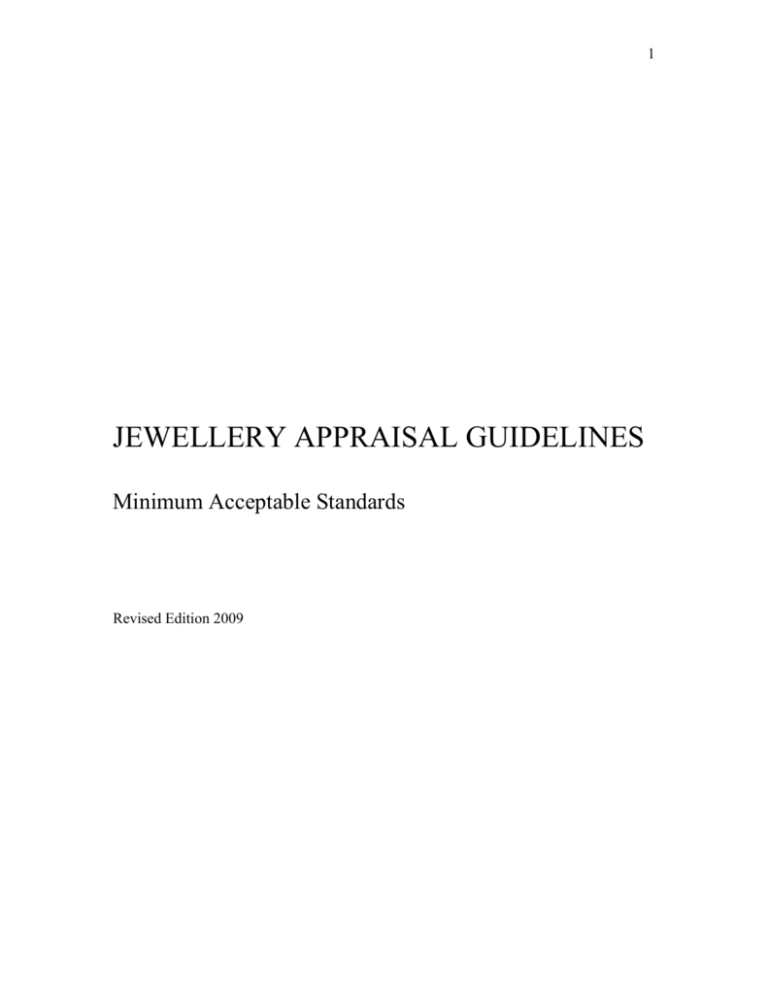
1
JEWELLERY APPRAISAL GUIDELINES
Minimum Acceptable Standards
Revised Edition 2009
2
Table of Content
PAGE
1.
Jewellery Appraisal Guidelines - Minimum Acceptable Standards
4
2.
Jewellery Appraisal Definitions
5
3.
Appraisal Documentation
6
4.
Value – Replacement and Fair Market
13
5.
Appraised Values and the Promotion of Jewellery Products
16
6.
Guide to Jewellery Descriptions for Appraisals
19
7.
Appendix I – Jewellery Descriptions
23
8.
Appendix II – Insurance Appraisal Checklist
33
3
Jewellery Appraisal Guidelines
Jewellery Appraisal Guidelines - Minimum Acceptable Standards (Guidelines).
Copyright 1998, revised 2005 and 2007 by Jewellers Vigilance Canada (JVC) and
Canadian Jewellers Association (CJA). Printed in Canada. All rights reserved. These
Guidelines, or parts thereof, may not be reproduced in any form without written
permission from the CJA and JVC.
Now
available
in
PDF
format
at
www.jewellersvigilance.ca
or
www.canadianjewellers.com.
For printed copies and/or further information about these Guidelines or the CJA’s
Accredited Appraiser Program (AAP) please contact the CJA at 1-800-580-0942 ext 223
or (416) 368-7616 ext 222.
Purpose of Guidelines
These Guidelines have been prepared to establish minimum acceptable standards to be
used by appraisers in the preparation of jewellery appraisals.
4
JEWELLERY APPRAISAL GUIDELINES
MINIMUM ACCEPTABLE STANDARDS
The appraiser requires a wide spectrum of knowledge, education, skills, tools and
resources. In some ways the appraiser may be seen as the conscience of the jewellery
industry.
The quality of an appraiser’s work largely depends upon attitude and approach as well as
knowledge, skills, resources and experience. These Guidelines do not attempt to address
this issue.
The quality of an appraisal will depend upon its content. These Guidelines present
acceptable standards for appraisal documents.
Members of the jewellery industry at all trade levels are advised that appraised
values used for the purpose of promoting the sale of jewellery products may raise
issues under the Competition Act administered and enforced by the Competition
Bureau, an independent law enforcement agency of the Government of Canada that
promotes and maintains fair competition in the marketplace. In that regard, the
section “Appraised Values and the Promotion of Jewellery Products” on Page 15 of
these Guidelines contains relevant information on how to avoid contravening the
misleading representations and deceptive marketing practices provisions of the
Competition Act.
It should be noted that under the Competition Act, a party who takes a
representation made by somebody else and transforms it into an advertisement of
his or her own, becomes responsible for the claim.
Note:
For the purposes of this document the term “jewellery” refers to gems, watches and any
precious metal items.
5
DEFINITION OF APPRAISAL
An expert unbiased opinion as to identity, composition, qualities and values, usually
embodied in a document which is the official record of the item.
An appraisal should also include a detailed description of the item using recognized
terminology and grading systems.
JEWELLERY INSURANCE APPRAISAL DEFINITION
A jewellery appraisal for insurance is a comprehensive description supporting an estimate
of the value to be used as the basis upon which insurance premiums will be set and
should be the basis of establishing the value and limit of claim settlement at the time of
an insured loss.
6
APPRAISAL DOCUMENTATION
The appraisal should include the following:
A.
Confidentiality
The recipient of the insurance appraisal document has been informed that the appraiser’s
files shall be treated as confidential and that the insuring company is fully entitled to all
information within the insurance appraisal and is just as entitled as the client to
explanations or answers to queries about the appraisal content.
B.
Credentials of Appraiser
The appraiser must define his or her professional expertise as a qualified appraiser.
There are two necessary components to perform an appraisal; gemmological training and
certification and valuation science training and certification.
Gemmological Training and Certification
Gemmological training and certification should be from a recognized institute or
association in the area relevant to the appraised item. The most commonly recognized
sources of gemmological training and certification are:
Canadian Gemmological Association
Fellow of the Canadian Gemmological Association — FCGmA
www.canadiangemmological.com
Gem-A, The Gemmological Association of Great Britain
Fellow of the Gemmological Association of Great Britain — FGA
www.gem-a.com
Gemological Institute of America
Graduate gemologist — GG
www.gia.edu
7
Valuation Science Training and Certification
Valuation science training and certification should be from a recognized institute or
association. The most commonly recognized sources of valuation science training and
certification are;
American Gem Society
Certified Gemologist Appraiser — C.G.A.
www.ags.org
American Society of Appraisers
Master Gemologist Appraiser
www.appraisers.org
Canadian Gemmological Association
Canadian Professional Jewellery Appraising
www.canadiangemmological.com
Canadian Jewellers Association
Accredited Appraiser Program (AAP)
www.canadianjewellers.com
École de Gemmologie de Montréal Inc.
Évaluateur diplômé /Graduated Appraiser
www.ecoledegemmologie.com
International Society of Appraisers
Certified Appraiser of Personal Property — ISA — CAPP
Accredited Member — ISA
www.isa-appraisers.org
MasterValuer Program
Registered Master Valuer
www.mastervaluer.com
8
National Association of Jewelry Appraisers
Certified Master Appraiser — C.M.A.
www.najaappraisers.com
C.
Appraiser’s Warranty
The appraiser warrants that:
Diamond and coloured gemstone grading is based on an internationally recognized
grading system.
The appraised item was inspected and tested utilizing all usual and minimum necessary
equipment of the gem laboratory and/or documentation for the complete and thorough
appraisal and identification of all properties of all components of the item.
A gem laboratory is defined as a secured area with a controlled environment for the
examination and testing of gems and jewellery. The minimum necessary equipment is;
microscope, refractometer, spectroscope, polariscope, metal testing equipment, heavy
liquids, reference library, jewellery cleaning equipment, gem carat weight scale, gold
scale, measuring devices, loupes, tweezers, appropriate illumination for diamond,
coloured stone and pearl grading, fibre optic light, short wave and long wave ultraviolet
illuminators, colour comparison tools and equipment for diamond, coloured gemstone
and pearl grading.
Metals are appropriately marked to indicate (or were tested and found to be of) the
specified purity.
To the best of the appraisers knowledge watches, watch parts and accessories, are
genuine parts supplied by the original vendor or manufacturer.
9
THE APPRAISER’S FEE IS NOT BASED ON THE ITEM’S VALUE
The appraiser should state any disclosure/limiting conditions.
(See Section J. page 10 – Disclosure/Limiting Conditions)
D.
Dating of Appraisal
The appraisal must state the date on which the item was examined.
If the item was not examined by the appraiser, details must be provided as to how
the description and value were determined.
e.g. - Hypothetical evaluation on a lost item based on a previous appraisal;
consultation with the insured regarding lost items.
E.
Name
If the appraiser performs an appraisal directly for the end-user, the name of the
person should be included in the appraisal.
If the appraiser performs an appraisal for the trade, the name of the firm may be
included at the discretion of that firm.
F.
Description
A complete guide to a proper jewellery appraisal description is included on Page
18.
Please refer to this section for definitions and further terms used in
descriptions. Any relevant conclusions as to identity, quality, quantity, or grading
of a whole item or any component of the item arrived at by the appraiser should
be mentioned as part of the appraisal description and information obtained by any
means of analysis should be kept in notes maintained by the appraiser for future
reference. Gem descriptions should conform with the rules laid out in
10
Canadian Guidelines With Respect to the Sale and Marketing of Diamonds,
Gemstones and Pearls” Revised Edition 2009.
G.
Signature
The appraisal must bear the signature of the appraiser or of an authorized
representative who is empowered to confirm the obligations with regard to the
appraisal. The name of the appraiser must be printed.
H.
Currency
The appraisal must specify the currency of the estimated value assigned to the
item(s). If a single appraisal covers a large number of items, the same currency
must be used throughout the appraisal.
I.
Value
The appraisal must state the expert opinion of value of the item. See Page 13 for
further information on Value.
J.
Disclosure/Limiting Conditions
Disclosure
Gemstones are considered natural unless otherwise stated.
Gemstones are
assumed to be treated by processes not detectable by the standard appraising
laboratory when such treatment is typical for that species and variety.
Please refer to Canadian Guidelines with Respect to the Sale and Marketing of
Diamonds, Gemstones and Pearls-Revised Edition 2009. It is incumbent upon the
appraiser to disclose any known and/or any identifiable treatments and any
11
synthetic or imitation materials.
The appraiser will disclose any supplied
information that was used in the appraisal of the item.
(e.g.: a mounted gemstone accompanied by a loose gemstone grading report)
Limiting Conditions
Any situation or condition that may impede or limit the ability of the appraiser to
conduct complete accurate analysis of gems or jewellery components.
(eg: type of setting, time limitations, lighting conditions, availability of proper
equipment, hypothetical appraisals for lost items, updates of appraisals without reexaminations of the item etc.)
K.
Professional and Ethical Standards
The following standards should be followed by all appraisers and indeed are appropriate
guidelines for any jewellery appraiser.
1. Services Provided
A. Examining, testing, analyzing and grading of gems, metals and jewellery
merchandise;
B. Reporting of identification, opinion of value, grade condition and damage of
gems and jewellery;
C. Consulting, advising and arbitrating with respect to jewellery industry
merchandise, its acquisition and disposition.
2. Responsibilities
A. To conduct laboratory testing and appraisal services in a manner that follows
these Guidelines, and reflects credit on the professional ability and business
ability of the appraiser;
B. To supply complete and accurate information based on scientifically correct
testing, careful analysis and knowledge of current market values;
C. To maintain confidentiality of information supplied to or received from a
client;
12
D. To prepare and issue reports in such a manner that their validity may be relied
on by any third party to whom the client may submit such a report, whether or
not the third party is known to the appraiser.
3. Professional Practices
A. Maintain integrity, dignity and professionalism in handling client’s property,
in preparing and issuing appraisal and/or gemmological reports, in advertising
and in the appearance of their business premises;
B. Maintain gemmological competence through continued training, practice and
study of current developments in the industry;
C. Render service only with respect to those articles and in those matters for
which the appraiser is qualified by training and experience, or for which the
appraiser has secured the assistance and advice of a qualified person;
D. Avoid unwarranted criticism of others engaged in the jewellery industry and
of their products;
E. Not conceal from an appraisal client the member’s interest in purchasing or
selling the article submitted for appraisal, and/or interest in selling a similar or
substitute article to the client;
F. Avoid bias and prejudice in formulating and submitting opinions on quality
and value;
G. Refrain from serving more than one party with respect to the same
controversy or legal action, except with the consent of all parties. This shall
not preclude reporting on the same article successively to more than one
client.
4. Reports
A. All reports of gemmological determination and appraisals shall be submitted
to the client in writing. Opinions and consultation can be verbal, provided an
accurate record of the discussion is maintained, whether conclusive or not;
B. Articles reported on shall be accurately described to permit positive physical
identification and to prevent misapplication of the report;
C. When used in a report, terms and abbreviations which have a special meaning
within the jewellery industry, and grading symbols applied to diamonds or
other gems, shall be defined either directly on the report or by reference to a
text made available to the client;
D. All conditions under which a report is issued shall be stated on the report.
These shall include: (1) the basis for valuations on the appraisal; (2) limiting
13
conditions under which the articles are examined, tested, or graded (such as
gem mountings and mounting designs which preclude precise determination
of gem weights and grades); (3) special limitations of equipment, lighting,
available time and/or location of articles being examined;
E. Reports that are tentative, partial, temporary or otherwise limited shall be so
labelled;
F. Physical arrangements of the report form and preparation of the report itself
shall be designed to prevent fraudulent alteration and/or deceptive use of the
report. All reports shall be addressed to a specific person, group or firm, shall
be dated, and shall be signed by the appraiser who issues the report or by an
authorized representative who is empowered to confirm the obligations of the
appraiser, with the signature to appear in conjunction with the legibly printed
or typed name;
G. Records of services rendered and copies of reports issued to the client shall be
maintained.
5. Other
The appraiser agrees, when necessary, to provide testimony and support
conclusions of value in a court of law. All fees for testimony shall be
predetermined prior to trial.
VALUE
Value is the monetary worth that an informed and willing buyer and seller would accept
for the sale of an item taking into consideration the given market conditions.
14
REPLACEMENT VALUE
(i)
Replacement Value New – the necessary cost to replace an item with a
new one of like kind, quality and utility.
(ii)
Replacement Value Comparable –the necessary cost to replace an item
with the nearest equivalent item of like kind, quality, utility and age having similar wear
and tear, decay or defects, and obsolescence as the appraised item.
FAIR MARKET VALUE
The dollar value that a willing buyer would pay and a willing seller would accept in an
open and unrestricted market, time not being of the essence and where the parties are
acting independently of each other (arms length transaction).
In Quebec jurisdiction the term “market value” is often used for “fair market value”.
LIQUIDATION MARKET
Liquidation value represents the most probable price at which an item will change hands
if sold with a very important time constraint, without regard to the most appropriate
market.
OTHER VALUE
There are circumstances that require other levels of value and this must be clearly defined
in the appraisal document.
ARRIVING AT VALUES
The two most frequently used approaches to arriving at values are:
(i)
Cost Approach – The perceived direct costs of producing the articles (stones,
metal, labour, hidden taxes, etc.) are totalled and a markup is applied to the
cost.
(ii)
Market Data Approach – The systematic research in the market place to find
pricing for comparable items.
In arriving at values, the appraiser must use a good range of price sources and the
following is a list of sources of pricing, both general and specific:
Wholesale dealers of coloured stones, on and off shore;
Wholesale dealers of diamonds, on and off shore;
Suppliers of jewellery metals;
15
Suppliers of findings and mountings;
Suppliers of finished gold items;
Antique and vintage jewellery dealers;
Auction Catalogues;
Internet.
Standardized price listings: (use as reference only, not as a sole source of
information) for example:
Palmieri’s Market Monitor;
The Guide;
Rappaport;
Auction Market Resources;
Price lists and consultation with local suppliers (often necessary on
a one by one basis with particular items);
Consultation with local appraisers and consultation with retailers;
“Window Shopping”, going out to compare prices at sources of
supply on a regular basis.
BRANDS
When the item being appraised is a “branded” item and therefore trademarked (i.e.
Tiffany&Co., Cartier etc…), the exact cost of replacing the item from the designer or
company should be obtained.
MARKETS
The purpose and function of an appraisal determines the most appropriate market in
which the appraiser will research the value. The most common markets are:
Retail market;
16
Auction market;
Liquidation market;
Wholesale market;
Internet;
Television shopping networks.
APPRAISED VALUES AND THE PROMOTION OF JEWELLERY PRODUCTS
Appraised values used for the purpose of promoting the sale of jewellery products may
raise issues under the misleading representations and deceptive marketing practices
provisions of the Competition Act administered and enforced by the Competition Bureau,
an independent law enforcement agency of the Government of Canada that promotes and
maintains fair competition in the marketplace.
The misleading representations and deceptive marketing practices provisions of the
Competition Act (Footnote 1)
The Competition Act contains provisions addressing false or misleading representations
and deceptive marketing practices in promoting the supply or use of a product or any
business interest. All representations, in any form whatever, that are false or misleading
in a material respect are subject to the Competition Act. If a representation could
influence a consumer to buy or use the product or service advertised, it is material. To
determine whether a representation is false or misleading, the courts consider the general
impression it conveys, as well as its literal meaning.
The Competition Act also specifically prohibits false or misleading ordinary selling price
representations. These prohibitions are aimed at protecting consumers from being misled
by reference to "inflated" regular prices when products are promoted at sale prices.
False or misleading representations and deceptive marketing practices can have serious
economic consequences, especially when directed toward large audiences or when they
take place over a long period of time. They can affect both business competitors who are
engaging in honest promotional efforts, and consumers.
Here is how jewellery appraised values could raise issues under the Competition Act
(Footnote 2)
For many consumers, the term "appraised value" represents the estimated market value of
a property on a given date, given by a qualified person. When the property is a jewellery
item, the "appraised value" represents the approximate price charged by jewellery
retailers in a given market at a given point in time. When "appraised values" are used by
jewellers in comparative price advertising situations, for example "Diamond Rings Appraised value $850, A deal at only $550", and these "appraised values" do not
represent genuine market prices, an issue may be raised under the ordinary selling price
provisions of the Competition Act. This type of representations could mislead consumers
to believe that they are receiving a percentage off the market price of the item.
From a more technical point of view, the "appraised value" of an item should not be used
in comparative advertising unless, in a relevant geographic market, the jewellery product
17
has been offered for sale in good faith at the "appraised value" for a substantial period of
time (more than 50% of the time in the last 6 months), OR a substantial volume of the
product (more than 50%) has been sold at the "appraised value" within a reasonable
period of time (12 months). In other words, in a relevant geographic market,
if the items have not been offered for sale in good faith at $850, 50% of the time or more
in the 6 months prior to the making of the representation, OR if more than 50% of the
items have not been sold at $850 in the preceding 12 months, an issue under the
Competition Act could be raised.
Issues under the Competition Act may also arise in non-comparative price advertising
situations. For example, if a jeweller were to advertise jewellery products displaying
grossly inflated "appraised values", an issue could be raised if these values are not
validated in the relevant geographic market.
Jewellers often believe that they do not attract liability under the Competition Act when
"appraised values" quoted in their advertising material are prepared by independent third
parties such as jewellery appraisers. It should be noted that under the Competition
Act, a party who takes a representation made by somebody else and transforms it
into an advertisement of his or her own, becomes responsible for the claim. A
situation might arise where both an appraiser and a jeweller could be subject to an
investigation. For example, if an appraiser were to misrepresent the value of a jewellery
product to a jeweller, and the jeweller were then to reproduce the "appraised value" in a
newspaper advertisement, both parties might be liable, although the particulars of each
contravention would differ slightly. The appraiser would be liable for his or her
representation to the jeweller, and the retailer would be liable for the representation in the
advertisement.
What Are the Possible Penalties?
The Competition Act provides two adjudicative regimes to address misleading
representations and deceptive marketing practices.
Under the criminal regime, certain practices are brought before the criminal courts,
requiring proof of each element of the offence beyond a reasonable doubt. On summary
conviction, the person is liable to a fine of up to $200,000 and/or imprisonment for up to
one year. If convicted on indictment, the person is liable to a fine at the discretion of the
court and/or imprisonment for up to five years.
Under the civil regime, certain practices may be brought before the Competition
Tribunal, the Federal Court or the superior court of a province and require that each
element of the conduct be proven on a balance of probabilities. The court may order a
person to cease the activity, publish a notice and/or pay an administrative monetary
penalty. On first occurrence, individuals are liable to penalties of up to $50,000 and
corporations are liable to penalties of up to $100,000. These amounts may double for
second and subsequent occurrences.
18
Written opinions
The Competition Bureau facilitates compliance with the law by providing various types
of written opinions subject to fees. Company officials, lawyers and others are encouraged
to request an opinion on whether the implementation of a proposed business plan or
practice would raise an issue under the Competition Act. These written opinions are
binding on the Commissioner of Competition when all the material facts have been
submitted by or on behalf of an applicant for an opinion and when they are accurate. A
specific written opinion will be based on information provided by the requestor and will
take into account previous case law, prior opinions and the stated policies of the Bureau.
How to contact the Competition Bureau
Anyone wishing to obtain additional information about the Competition Act, the Precious
Metals Marking Act, the Consumer Packaging Labelling Act and the Textile Labelling
Act should contact the Competition Bureau’s Information Centre at:
Telephone
Toll free:
1-800-348-5358
National Capital Region:
(819) 997-4282
TDD (for hearing impaired): 1-800-642-3844
Facsimile
(819) 997-0324
Address
Information Centre
Competition Bureau Canada
50 Victoria Street
Gatineau, Quebec
K1A 0C9
Web site
www.cb-bc.gc.ca
E-mail
compbureau@cb-bc.gc.ca
(1)
The misleading representations and deceptive marketing practices provisions of
the Competition Act include sections 52 to 60 contained in Part VI and sections 74.01 to
74.08 contained in Part VII.1.
(2)
Specifically section 52, paragraph 74.01(1)(a) and subsection 74.01(2) of the
Competition Act.
19
GUIDE TO JEWELLERY DESCRIPTIONS FOR APPRAISALS
(For a more detailed description, please refer to APPENDIX I on page 23)
1.
Visual Examination
a)
Type of Jewellery including, but not limited to:
Ring - solitaire, cluster, band, family ring, eternity band;
Earrings - stud, drop, hoop;
Necklaces – link, bead;
Neck chains - link chains of various styles;
Bracelets - bangles, charm bracelets, link bracelets of varying
styles;
b)
Brooches/Pins - bar brooches, stick pins;
Pendants.
Quantity of Piece (s)
Terms used in describing quantity of items usually include: one, single,
pair, set, matching set.
c)
Gender Style or Age Group
If jewellery is known to be a woman’s, man’s or child’s style of jewellery,
a reference to this may be noted.
d)
Age or Antiquity
If the age or circa date of a piece of jewellery is known or can be
estimated it should be indicated in the appraisal description by an
indication of the approximate date of production, or by referring to the
period to which it belongs: (eg: modern, contemporary, Art Deco, Art
Nouveau, Retro, Edwardian, Victorian, etc.) The appraiser should also
state whether the piece is a reproduction of a certain period if it is known.
20
e)
f)
Mounting:
type of setting;
karatage;
colour;
metal type;
quality mark and trademark;
type of manufacture;
dimensions.
Gems (specify if mounted or loose):
identification;
shape;
cutting style;
dimensions in millimetres for each stone;
colour grade or colour description (tone, saturation, hue);
clarity grade;
weight (individual weight of major stone(s), combined weight for
secondary stones);
cut grade.
Jade, include:
texture or patterning;
transparency;
polish.
Opal, include:
potch percentage;
play of colours involved;
21
intensity;
pattern;
background colour;
Pearl, include:
cultured or natural;
fresh water or salt water;
shape;
colour and overtone;
lustre;
nacre thickness;
blemish;
number of pearls;
approximate millimetre sizing.
NOTE: If any of the above is estimated, please specify.
IN ADDITION TO THE ABOVE:
Treatment or Enhancement
Gemstones are considered natural unless otherwise stated. Gemstones are
assumed to be treated by processes not detectable by the standard appraising
laboratory when such treatment is typical for that species and variety. Any
detectable process other than cutting and polishing that alters the colour,
clarity phenomenon and/or durability of a gem shall be disclosed.
g)
Watch, include (if available):
description;
manufacturer;
22
style;
serial number;
movement description (eg. type of movement, serial number, number
of jewels, features and options);
case information (manufacturer, style and serial number);
strap/bracelet information (description, manufacturer and style
number);
bezel and dial information;
crystal description.
NOTE: If watchcase is not opened, please specify.
h)
Gross weight.
NOTE: The appraisal should include any other relevant information ie: condition of
item.
2. Photographs
A photograph or digital image of the item should accompany the appraisal but
should not be depended upon to take the place of a detailed description. The
appraisal should state if the photo or digital image is or is not to scale.
23
APPENDIX I
JEWELLERY DESCRIPTIONS
A.
MAJOR STONES
A “major gemstone” is defined as a solitary stone in an item of jewellery, or a central or
focal stone in an item of jewellery in either component value or design. A “major stone”
is described individually, and must be identified in terms as follows:
1. Identification:
The stone must be identified by species and correct variety name.
2. Natural, Cultured, Treated, Synthetic, Assembled, Imitation:
The nature of the gem and whether it is treated (if identifiable, including the
method of treatment), natural (when it can be ascertained that no treatment has
altered the colour, clarity, or phenomena in a stone), synthetic (type of synthesis if
identifiable, e.g. “flame fusion” or “hydrothermal”), assembled (naming
components unless these are obvious by trade conventions), or imitation.
Cultured refers to pearls only.
3. Carat Weight and Dimensions
The dimensions of the stone, expressed in millimetre measurements to at least one
decimal place:
For round stones: Minimum and maximum diameter and depth;
For triangular stones: Base (corner to corner), altitude (side to corner) and
depth;
24
For other shapes: Length, width, height, depth;
For irregular shapes: Maximum, minimum (or width perpendicular to
maximum), and depth;
For hollow stones (such as carbuncle): A thickness should also be given.
Weights of gems are to be stated, in metric carats, to two decimal points, and are
to be described as estimated if they are;
Bulge factor used in estimating the weight of a coloured stone may be provided in
the description of a stone.
4. Shape and Type of Cut
The shape of the stone must be given: e.g. round, square, oval;
The style of cut of a stone must be given: e.g. faceted or cabochon, brilliant or
step;
In describing the cut of stone, the shape is to be used to qualify the style of cut;
e.g. round brilliant cut, oval mixed cut, square step cut.
5. Cut
“Make”, “cut”, or “cutting grade” of any major stone will be specified, and the
quality of the make of the stone must be stated in terms that are accessible to the
user of the description, either by a stated internationally recognized standard, or in
terms clearly explained on the appraisal. This is an important determining factor
in the value of a stone and if possible should be stated. Girdle thickness and
specific proportions of major stones, if possible, should also be stated.
25
6. Clarity
All major stones must bear a clarity grade that uses terminology used in an
internationally accepted system or if other terminology is used, it must be cross
referenced to an internationally recognized system. The type, size and locations
of the inclusions may be stated.
7. Colour
Colour must be described in terms of:
Hue, e.g. blue, red, green, orange. Modifying hue should be included,
if any is present, e.g. purplish red, yellowish green;
Tone, in terms such as very light, light, medium light, medium,
medium dark, dark, very dark;
Intensity, in terms such as vivid, intense, strong, medium strong,
medium, medium low, low (or similar terms);
Evenness of colour, zoning, mottling, lack of colour should be
described;
Diamond colour must be stated in an internationally recognized system
such as GIA D through Z and fancy, plus method of grading should be
stated, e.g. GIA graded master diamonds.
8. Polish and finish may be qualitatively described in conjunction with a “cut”, or
“make” grade description.
9. Any damage will be described by type and location: e.g. chipped culet, nicked girdle,
surface reaching fracture, abrasions on the crown.
10. In stones in which transparency is of particular note or is unusual for the material, the
26
transparency is to be described.
11. In phenomenal stones the phenomenon is to be described, but not limited to the
following:
Opal - Type of opal, intensity of play of colour, primary colours,
secondary colours, patterns, extinguishing of play of colour;
Pearls - Natural, cultured, number of pearls, length of strands, graduated
or uniform (if in strands), size range (in half millimetre increments),
shape, body colour, lustre, overtones, nacre thickness, orient, blemishing,
matching;
Colour change stones - degree of colour change, description of colours
seen (with accompanying description of type of light source in which
colour is seen);
Adularescence, aventurescence, iridescence, labradorescence - centring
and strength of phenomenon;
Asterism - Number of rays, centring, sharpness, strength of star,
straightness of rays;
Chatoyancy - Centring, sharpness, strength of eye, straightness, opening
and closing of eye.
B. SECONDARY STONES
Stones that are not the focal visual or value component of the item can be grouped
together by type, approximate size, qualities (shape, colour, clarity), with total
estimated weights provided for groupings.
Descriptions will be provided as
described for major stones but can be given individually or as a average for
groups of matching material of similar qualities.
27
C. METAL, CONTENT and STAMPED MARKS
Gold - Colours including: yellow, green, red and white;
Karat: 9K to 24K or 375 to 999.99;
Silver – If known, purity should be specified eg: 925, Sterling;
Platinum – If known, purity and composition should be stated;
Other – eg: but not limited to below 9K gold, gold-filled, vermeil, gold
electroplating, rolled gold plating;
Karat Stamps - if the karat stamp is not marked then the item should be
tested to determine what the metal is and what karat, if gold, it is. An
electronic metal tester or acids may be used to determine the results. It
should be stated on the appraisal whether the metal was tested or not
and the testing may have limiting conditions;
Hallmarks and other national marks are frequently seen in jewellery.
If mentioning the origin of these hallmarks, a reference must be made
to country, city and year, if available;
Trademarks - most jewellery is trademarked with a manufacturer’s
mark. Trademarks may be recognized as letters, shapes, figures or
animals, or the name of the trademark holder, and should be described
in the appraisal.
PRECIOUS METALS MARKINGS
The Precious Metals Marking Act (PMMA), administered and enforced by the
28
Competition Bureau, prescribes uniform methods of marking precious metals articles
made in whole or in part of gold, silver, platinum or palladium and prohibits markings
that do not truly and correctly indicate the quality of the precious metal content.
Acceptable quality marks and minimum quantity of precious metal for articles other than
plated articles are described in section 6 of the Precious Metals Marking Regulations
(PMMR) and are summarized in the following table.
Precious Metals
Quality Marks
Minimum
Quantity
Precious Metal
of
Gold
"Karat", "karat", "Carat",
"carat", "KT, "Ct", "K", "C"
9 karats
e.g., 10k, 14k, 18k
decimals: ".416", ".583",
".750"
Silver
"silver", "sterling", "argent", 925 parts by weight in every
"sterling silver", "argent 1,000 parts pure silver
sterling"
decimal: .925
Platinum
"platinum", "plat" or "platine" 95% platinum, or
95% platinum and iridium, or
95% platinum and ruthenium
Palladium
"Palladium" or "Pall."
95% palladium, or
90% palladium and 5%
platinum, iridium, ruthenium,
rhodium, osmium or gold
Section 7 of the PMMR describes acceptable quality marks and the specifications for
plated articles while sections 8 to12 describe acceptable quality marks and specifications
for watch cases, bracelet watch cases, plated flatware and plated hollow ware.
In accordance with section 2 of the PMMA, a “mark” includes any mark, sign, device,
imprint, stamp, brand, label, ticket, letter, word or figure.
Quality Marks - It is not mandatory to mark or advertise a
precious metal article for quality, however, any reference made as to the
quality of a precious metal article must be factual and disclosed in the
prescribed manner. A quality mark may be applied to a precious metal
article by any method - (subsections 4(1) and 4(2) of the PMMA)
Trademarks - Where a quality mark is applied to a precious metal
article, it must bear a trade-mark that has either been applied for or
registered with the Registrar of Trade-marks, Canadian Intellectual
Property Office, Industry Canada - (subsection 4(3) of the PMMA).
The trade-mark must be applied by the same method as the quality mark (subsection 5(2) of the PMMR).
29
Hallmarks and Foreign Government Marks - If a precious
metal article is hallmarked according with the laws of the United Kingdom
or has a foreign government mark applied according to the laws of the
foreign country which truly and correctly indicates the quality of the
precious metal, it does not require a trade-mark and may have a quality
mark applied to it as per the Regulations - (subsection 4(4) of the PMMA).
Canadian National Mark - A national mark consists of a
representation of a maple leaf surrounded by the letter “C”. The
Commissioner of Competition can authorize a dealer to apply this mark to
an article wholly manufactured in Canada if it is composed of a precious
metal which has a quality mark prescribed in the Regulations and is
quality-marked - (section 5 of the PMMA).
Anyone wishing to obtain additional information about the Precious Metals
Marketing Act should contact the Competition Bureau’s Information Centre
whose coordinates can be found on Page 17 of this document.
D. PROCESS OF MANUFACTURING
If known, the manufacturing method of an item of jewellery should be mentioned.
These methods include:
Handmade;
Cast;
Die struck;
Hand assembled;
Machine made.
An understanding of quality in the various types of manufacturing methods is
very important to the appraiser. A common design should not be assumed to be a
production piece nor should a custom design be assumed to have been cast. The
analysis of manufacturing methods is important in estimating the cost of the item.
E. OTHER DESCRIPTIONS
Shape, Style and/or Motif
30
Jewellery styles may be described by common trade names (e.g. crossover
style ring, round, hollow, dome shaped earrings, bow-tie style brooch”) or
other general terms such as ribbon, wave, step, shield, butterfly, concave,
rectangle, square, teardrop, oval, ballerina, etc. Ring shank descriptions
and terms may include split, flat tapered, half round, knife edge, double
split, and raised bordered.
Sizes
Significant dimensions of jewellery items (length, width, depth and/or
thickness as appropriate) should be accurately reported. Ring size may
also be reported.
Chain
Chain link styles may be referred to by trade name (e.g. Gucci) or by
descriptive names which may include, rope (twisted), box (twisted),
serpentine (twisted), curb, cable, foxtail, herringbone, C-link, zipper,
wheat, cobra, mesh, Figaro, etc.
Stone Setting Styles and Patterns
The style, arrangement, and colour (if different from other parts of the
item) of settings should be reported. Some examples of types of settings
include: 4 prong (claw), 6 prong (claw), buttercup, split prong (claw), fish
tail, bezel, pave, tube illusion, channel, half bezel, Gypsy illusion, bead
set, Roman, invisible, basket multi-claw, fancy filigree claw set, scroll
filigree Roman set, graduated channel, and multi-level random setting.
31
Decorative Details
A motif is a design feature which is repeated and may be raised,
indented, perforated, applied or incorporated into the outline shape of
the item.
Example motifs may include foliate, leaf, scroll, floral,
scalloped, animal.
Texture describes a surface finish, and some examples of finishes on
metal include high polished, brushed, sandblasted, bark, Florentine,
ribbed, scaled, hand engraved.
Embellishments are additions (material or decorative detail other than
texture) to enhance or beautify the main piece.
Examples would
include: enamel, twisted wire borders, milgraining and granulation.
Necklaces, Neck chains and Bracelets - These should be described using trade
name. Measurements should also be recorded for length, width and thickness.
–
Clasps, Closures and Bales - Some examples of clasp and closure should
include: box clasps (hidden), fish hook (filigree), spring rings, barrel clasps,
lobster clasps, sister hooks, hidden bead clasps, screw clasp, safety chains,
figure eight safety catch.
Earrings – Some examples of findings: omega clips, French backs, post and
butterfly, threaded stud, shepherds hook, screw backs and clip backs.
32
Brooches – Some examples of closures include: hinged bar catch, hook catch,
safety pin catch, roll-over pinstem catch, side-swing pinstem catch, sliding
tube pinstem catch.
Pendants – Some examples of bale findings: V-bale, split bale, straight bale,
tapered, ribbed.
Connectors used to assemble two-part earrings, multi-drop pendant brooches,
necklaces or bracelets should be described and measured. Some examples of
these findings are: jump rings, rivets, bar links, pins and posts.
F.
GROSS WEIGHT
The gross weight of each item, the total gross weight of each pair or set or the
average gross weight of each like item in a set should be accurately reported in
grams to at least one decimal place.
33
APPENDIX II
INSURANCE APPRAISAL CHECKLIST
The insurance appraisal for a jewellery item should include the following:
Appraiser Information
Credentials;
Appraiser’s warranty;
Date of appraisal;
Date of examination of item (if different from date of appraisal);
Printed name and signature of appraiser or authorized representative.
Descriptions
Name and address of person or firm for whom the appraisal was prepared (if
applicable);
Type of item;
Quantity of pieces;
Gender style (if applicable);
Metal & content analysis;
Trademarks and quality marks;
Description of major stones;
Description of secondary stones;
Total gross weight of item;
Photograph(s);
Currency used;
Disclosure/limiting conditions (if applicable).
34

